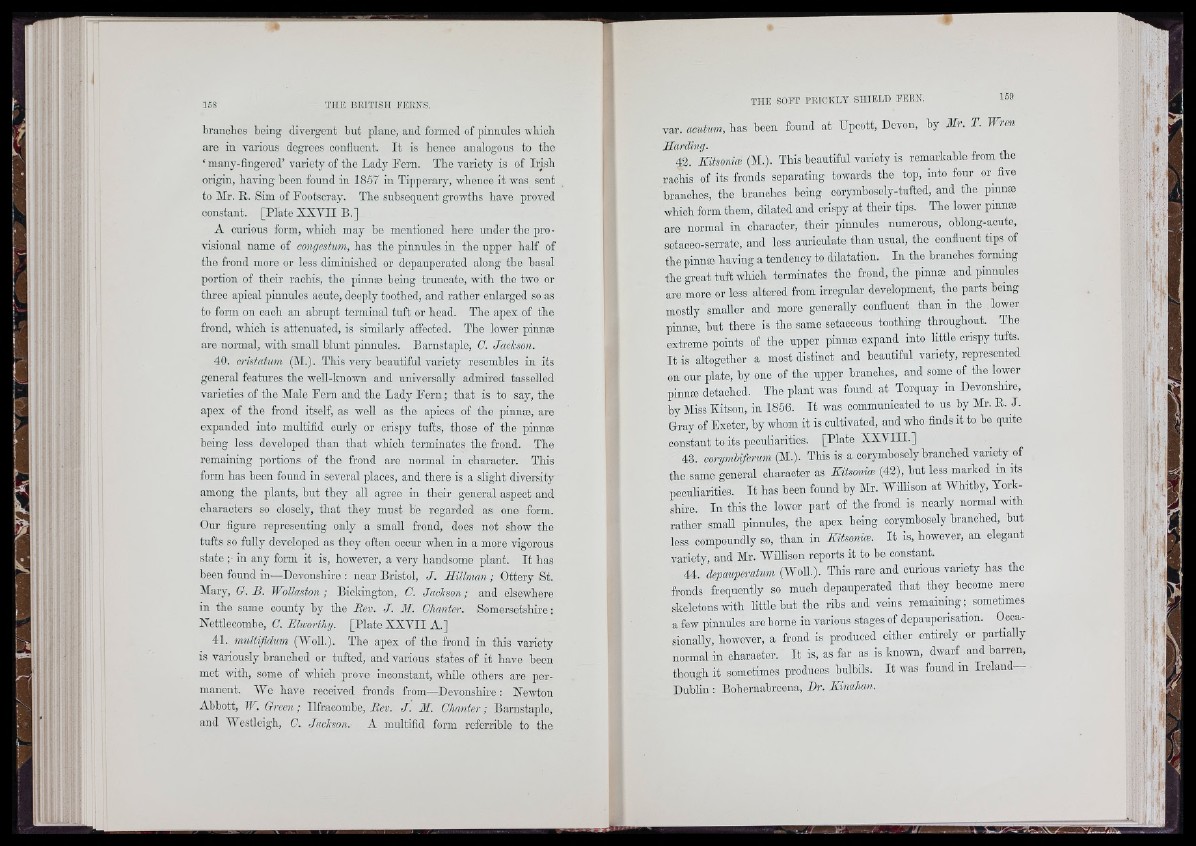
branches boing ciivorgent but plane, and formod of pinnules which
arc in various degrees confluent. I t is honoo analogous to tho
‘ many-fingorcd’ variety of the Lady Fern. The variety is of Irish
origin, having been found in 1857 in Tipporar};, whence it was sent
to Mr. R. Sim of Footsoray. The subsequent growths have proved
constant. [Plate XXVII B.]
A curious form, which may bo mentioned horo under tho provisional
name of congestnm, has the pinnules in the upper half of
the frond more or less diminished or depauperated along tho basal
portion of thoir raohis, the pinnæ being truncate, with the two or
threo apical pinnules aouto, deeply toothed, and rather enlarged so as
to form on each an abrupt terminal tuft or head. The apex of the
frond, which is attenuated, is similarly affected. Tho lower pinnæ
are normal, with small blunt pinnules. Barnstaple, C. Jachson.
40. cristatum (M.). This very beautiful variety resembles in its
general features the well-known and universally admired tasselled
varieties of tho Male Fern and the Lady Fern ; that is to say, the
apex of the frond itself, as woll as tho apices of the pinnæ, are
expanded into multifid curly or crispy tufts, those of the pinnæ
being loss developed than that which terminates tho frond. The
remaining portions of the frond aro normal in character. This
form has been found in several places, and there is a slight diversity
among tho plants, hut they all agree in thoir general aspect and
characters so closely, that they must ho regarded as one form.
Our figure representing only a small frond, docs not show the
tufts so fully developed as they often occur when in a moro vigorous
state ; in any form it is, however, a very handsome plant. I t has
been found in—Devonshire : near Bristol, J . Hillman ; Ottory St.
Mary, G. B. Wollaston ; Bickington, 0. Jachson ; and elsewhere
in the samo county by the Rev. J . 31. Chanter. Somersetshire:
Nettlecombe, C. Ehcorthy. [Plate X XV II A.]
41. multifidum (IVolL). The apex of the frond in this variety
is variously branched or tufted, and various states of it havo boon
mot with, some of which prove inconstant, while others are permanent.
IVo have received fronds from—Devonshire : Newton
Abbott, W. Green; Ilfracombe, Ai®. J . 31. Chanter; Barnstaple,
and Y estloigh, C. Jachson. A multifid form reforriblo to the
var. acutum, has boon found at Upcott, Devon, by 3Ir. T. Wren
Harding.
42. Kitsoniæ {M.). This beautiful variety is remarkable from the
rachis of its fronds separating towards the top, into four or^ five
branches, the branches being corymbosoly-tufted, and the pmnoe
which form thorn, dilated and crispy at thoir tips. The lower pinnæ
aro normal in character, their pinnules numerous, oblong-acnte,
setaceo-serrate, and less auricnlato than usual, the confluent tips of
the pinnæ having a tendency to dilatation. In the branches forming
the groat tuft which terminates tho frond, the pinnæ and pinnules
aro moro or less altered from irregular development, the parts being
mostly smaller and moro gonorally confluent than m tho lower
pinnæ, but there is tho same setaceous toothing throughout. Tho
extreme points of the upper pinnæ expand into little crispy tufts.
I t is altogether a most distinct and beautiful variety, represented
on our plate, by one of the upper branches, and some of the lower
pinnæ detached. The plant was found at Torquay in Devonshire,
by Miss Kitson, in 1856. I t was communicated to us by Mr. R. J.
Gray of Exetor, by whom it is cultivated, and who finds it to be quite
constant to its peculiarities. [Plato X X V III.]
43. corymUferum (M.). This is a corymbosely branched variety of
the samo general oharaoter as Küsonioe (42), but less marked in its
peculiarities. I t has been found by Mr. Willison at AVhitby, Tork-
shiro. In this the lower part of the frond is nearly normal with
rather small pinnules, the apox being corymbosely branched, but
less compoundly so, than in Kitsoniæ. I t is, however, an elegant
variety, and Mr. Willison reports it to bo constant.
44. depaupcratum (Woll.). This raro and curious variety has tho
fronds frequently so much depauperated that they become mere
skeletonsYvith little but the ribs and veins remaining; sometimes
a few pinnules aro horno in various stages of depauperisation. Occasionally,
however, a frond is produced either entirely or partially
normal in character. I t is, as far as is known, dwarf and barren,
though it sometimes produces bulbils. I t was found m Ireland
Dublin : Bohornabroena, Br. Kinahan,